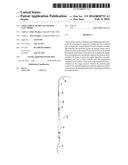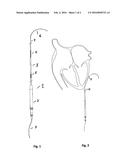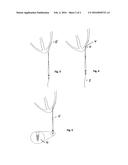Patent application title: MYOCARDIAL HEART PACEMAKER ELECTRODE
Inventors:
Peter Osypka (Grenzach-Wyhlen, DE)
Peter Osypka (Grenzach-Wyhlen, DE)
IPC8 Class: AA61N105FI
USPC Class:
607129
Class name: Placed in body heart patch or epicardial (on heart surface) type
Publication date: 2016-02-04
Patent application number: 20160030733
Abstract:
The invention relates to a bipolar myocardial pacemaker electrode (1)
consisting of a plug (2), a supply line (3), a cathode (4), an anode (5),
surgical thread (7) and a fixation member (8), whereby the electrode (1)
has an internal lumen and is freely movable on the thread (7); the thread
(7) can be guided through the inner lumen of the electrode including the
supply line and plug thereof, and distally supports the fixation member
(8) in the form of a knot; the supply line (3) is externally insulated
and has a distal cathode pole (4) tangentially arranged on the surface of
the heart in the heart tissue (myocardium) in the usage position, wherein
the cathode pole consists of a conically tapering coil and the supply
line (3) has an anode pole (5) arranged proximally underneath the heart
in the usage position.Claims:
1. A bipolar myocardial pacemaker electrode comprising: a plug, a supply
line, a cathode, an anode, surgical thread and a fixation member, wherein
the electrode has an internal lumen and is freely movable on the thread;
the thread can be guided through the inner lumen of the electrode
including the supply line and plug thereof, and the thread distally
supports the fixation member in the form of a knot; the supply line is
externally insulated and has a distal cathode pole tangentially arranged
on the surface of the heart in the heart tissue (myocardium) in the usage
position, wherein the cathode pole consists of a conically tapering coil
and the supply line has an anode pole arranged proximally underneath the
heart in the usage position.
2. The bipolar myocardial pacemaker electrode according to claim 1, wherein the poles are made of a biocompatible electrically conductive material, such as platinum, stainless steel or MP 35N.
3. The bipolar myocardial pacemaker electrode according to claim 1, wherein the supply line of the electrode consists of a coil with at least two parallel wound insulated wires.
4. The bipolar myocardial pacemaker electrode according to claim 1, wherein the supply line of the electrode consists of at least a coil and an insulated strand.
5. The bipolar myocardial pacemaker electrode according to claim 1, wherein the supply line of the electrode comprises at least two insulated strands.
6. The bipolar myocardial pacemaker electrode according to claim 1, wherein the external insulation of the supply line comprises a shaft tube of silicone or polyurethane.
7. The bipolar myocardial pacemaker electrode according to claim 1, wherein the plug pin has a slot, in which the rest of the surgical thread can be fastened.
Description:
[0001] The invention relates to a bipolar myocardial permanent pacemaker
electrode, especially suitable for children, with gentle fixation on the
surface of the heart. In use the electrode pole is tangentially arranged
on the surface of the heart in the heart tissue (myocardium) with a
connection linking it to a pacemaker.
[0002] Myocardial pacemaker electrodes are already known from DE 2 219 044.9 from U.S. Pat. No. 4,355,642 and from WO 2005/039691.
[0003] Children born with a heart defect may require a pacemaker electrode after surgery. The known electrodes are too large compared to the children's heart size and may cause problems. For bipolar stimulation even two of these large electrodes often have to be attached to the baby's heart.
[0004] There is a need to provide a myocardial electrode as described above, in which the size and fixation of the electrode is adapted to a child's heart.
[0005] The invention relates to a bipolar myocardial pacemaker electrode (1) consisting of a plug (2), a supply line (3), a cathode (4), an anode (5), surgical thread (7) and a fixation member (8), whereby the electrode (1) has an internal lumen and is freely movable on the thread (7); the thread (7) can be guided through the inner lumen of the electrode including the supply line and plug thereof, and distally supports the fixation member (8) in the form of a knot; the supply line (3) is externally insulated and has a distal cathode pole (4) tangentially arranged on the surface of the heart in the heart tissue (myocardium) in the usage position, wherein the cathode pole consists of a conically tapering coil and the supply line (3) has an anode pole (5) arranged proximally underneath the heart in the usage position.
[0006] The surgical thread is inserted at the appropriate point in the myocardium using a heart needle. At the point at which the needle is drawn out of the myocardium a knot is made and the rest of the thread and needle is removed. The knot serves as a fixation member (barbed hook). The manufacturer has already guided the thread through the inner lumen of the electrode including its supply line and plug, so that the electrode is freely movable on the thread.
[0007] The pole of the electrode (cathode (4)) designed as a thin coil can now be easily drawn over the thread into the myocardium. The tread serves as a guide. The remaining thread protruding out of the electrode plug (2) is anchored in the plug pin. The anode (5) (indifferent pole) of the bipolar myocardial electrode is arranged proximally on the electrode supply line as a coil below the heart.
BENEFITS
[0008] The myocardial pacemaker electrode is fastened only by a small knot in a surgical thread and the anode is placed below the heart. There is no need for a second separate electrode as an anode. The electrode is easily movable on the thread, thus the cathode (4) can be optimally positioned.
DRAWINGS
[0009] Further details, features and benefits of the invention can be found in the following part of the description, in which the invention is explained in more detail using drawings. They drawings show the following in a schematic presentation.
[0010] FIG. 1 An execution example of the myocardial pacemaker electrode in which a surgical thread is inserted.
[0011] FIG. 2 An execution example of the myocardial pacemaker electrode in which a surgical thread is inserted into the myocardium.
[0012] FIG. 3 An execution example of the myocardial pacemaker electrode in which a knot is made using the surgical thread, the remaining thread is removed and the knot is pulled back to the outer wall of the heart.
[0013] FIG. 4 An execution example of the myocardial pacemaker electrode in which the electrode's distal pole (cathode) is drawn into the myocardium via the surgical thread.
[0014] FIG. 5 An execution example of the myocardial pacemaker electrode in which the proximal part of the surgical thread is anchored in the plug pin.
DESCRIPTION OF THE DRAWINGS
[0015] FIG. 1 shows an execution example of the myocardial pacemaker electrode (1) consisting of a plug (2), shaft tube or supply line (3), cathode (4), anode (5), heart needle (6) and the surgical thread (7), which runs through the entire length of the electrode.
[0016] The poles (cathode pole (4), anode pole (5)) are made of a biocompatible electrically conductive material. Examples mentioned are platinum, stainless steel or MP 35N.
[0017] The supply line (3) of the electrode (1) consists of a coil with at least two parallel wound insulated wires or of at least a coil and an insulated strand. The supply line (3) of the electrode (1) may also comprise at least two insulated strands. The supply line (3) must be insulated on the outside. The outer insulation of the line consists of a shaft tube of silicone or polyurethane, for example.
[0018] It is advantageous if the rest of the thread (7) is fastened. For this purpose the plug pin (10) has a slot in which the rest of the surgical thread can be fastened.
[0019] FIG. 2 shows an execution example of the myocardial pacemaker electrode (1) in which a surgical thread (7) is inserted through the myocardium. The cathode (4) is drawn into and positioned in the myocardium based on the fastening shown in FIG. 3 with the aid of the thread (7).
[0020] FIG. 3 shows an execution example of the myocardial pacemaker electrode (1) in which a knot (8) is made in the surgical thread (7), the remaining thread is removed and the knot has been drawn back to the outer wall of the heart.
[0021] FIG. 4 shows an execution example of the myocardial pacemaker electrode (1) in which the distal pole (cathode) (4) of the electrode is inserted via the surgical thread (7) into the myocardium (9).
[0022] FIG. 5 shows an execution example of the myocardial pacemaker electrode (1) in which the proximal section of the surgical thread is anchored in the plug pin (10). The anode (5) of the electrode is formed into a coil and lies below the heart while in use.
User Contributions:
Comment about this patent or add new information about this topic:
| People who visited this patent also read: | |
| Patent application number | Title |
|---|---|
| 20180093270 | CENTRIFUGAL FLUID SEPARATION DEVICE |
| 20180093269 | MICROFLUIDIC VALVES AND DEVICES |
| 20180093268 | Microfluidic device and method for manufacturing the same |
| 20180093267 | ROTATABLE CARTRIDGE WITH A METERING CHAMBER FOR ANALYZING A BIOLOGICAL SAMPLE |
| 20180093266 | Connectors For Pneumatic Devices In Microfluidic Systems |



